

Aesthetics. "Aesthetician" redirects here.

For a cosmetologist who specializes in the study of skin care, see Esthetician. More specific aesthetic theory, often with practical implications, relating to a particular branch of the arts is divided into areas of aesthetics such as art theory, literary theory, film theory and music theory. An example from art theory is aesthetic theory as a set of principles underlying the work of a particular artist or artistic movement: such as the Cubist aesthetic.[6] Thomas Aquinas. Thomism - Wikipedia. Descartes. Aristotle. Aristotle's views on physical science profoundly shaped medieval scholarship.
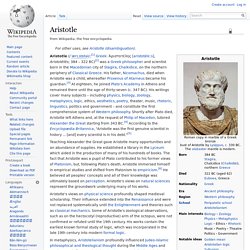
Their influence extended into the Renaissance and were not replaced systematically until the Enlightenment and theories such as classical mechanics. Prince Hamlet - Wikipedia. Role in the play[edit] Hamlet devises a test to see whether Claudius is guilty: he hires a group of actors to perform a play about the murder of a king in front of the royal court, and waits to gauge Claudius' reaction.
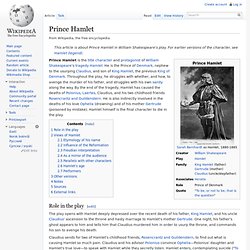
When Claudius leaves the audience deeply upset, Hamlet knows that the ghost was telling the truth. He follows Claudius into his chambers in order to kill him, but stops when he sees his uncle praying; he does not want to kill Claudius while he is in a state of grace. A second attempt on Claudius' life ends in Polonius' accidental death. Claudius, now fearing for his life, sends Hamlet to England, accompanied (and closely watched) by Rosencrantz and Guildenstern. In the Elsinore churchyard, two "clowns", typically represented as "gravediggers," enter to prepare Ophelia's grave. Later that day, Hamlet tells Horatio how he escaped death on his journey, disclosing that Rosencrantz and Guildenstern have been sent to their deaths instead.
Daedalus - Wikipedia. Family[edit] The Labyrinth[edit] Daedalus is first mentioned by Homer as the creator of a wide dancing-ground for Ariadne.[12] He also created the Labyrinth on Crete, in which the Minotaur (part man, part bull) was kept.

In the story of the labyrinth as told by the Hellenes, the Athenian hero Theseus is challenged to kill the Minotaur, finding his way with the help of Ariadne's thread. Daedalus' appearance in Homer is in an extended metaphor, "plainly not Homer's invention", Robin Lane Fox observes: "he is a point of comparison and so he belongs in stories which Homer's audience already recognized".[13] In Bronze Age Crete, an inscription da-da-re-jo-de has been read as referring to a place at Knossos,[14] and a place of worship.[15] In Homer's language, objects which are daidala are finely crafted.
This story thus encourages others to consider the long-term consequences of their own inventions with great care, lest those inventions do more harm than good. Landscape with the Fall of Icarus" On "Landscape with the Fall of Icarus" Audrey T.
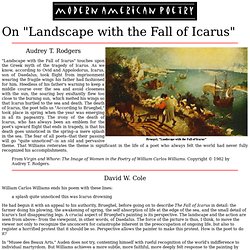
Rodgers. Telemachus - Wikipedia. Telemachus (/təˈlɛməkəs/; Greek: Τηλέμαχος, Tēlemakhos, literally "far-fighter")[1] is a figure in Greek mythology, the son of Odysseus and Penelope, and a central character in Homer's Odyssey.
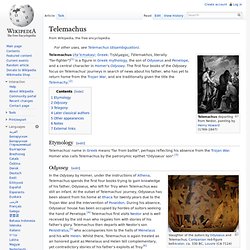
The first four books of the Odyssey focus on Telemachus' journeys in search of news about his father, who has yet to return home from the Trojan War, and are traditionally given the title the Telemachy.[2] Etymology[edit] Telemachus' name in Greek means "far from battle", perhaps reflecting his absence from the Trojan War. Homer also calls Telemachus by the patronymic epithet "Odysseus' son".[3] Odyssey[edit] The Odyssey returns focus to Telemachus upon his father's return to Ithaca in Book XV. Friedrich Nietzsche. Friedrich Wilhelm Nietzsche (/ˈniːtʃə/[1] or /ˈniːtʃi/;[2] German: [ˈfʁiːdʁɪç ˈvɪlhɛlm ˈniːt͡sʃə]; 15 October 1844 – 25 August 1900) was a German philosopher, cultural critic, poet, composer and Latin and Greek scholar.

He wrote several critical texts on religion, morality, contemporary culture, philosophy and science, displaying a fondness for metaphor[3] and irony. Nietzsche's key ideas include perspectivism, the will to power, the death of God, the Übermensch and eternal recurrence. One of the key tenets of his philosophy is "life-affirmation", which embraces the realities of the world in which we live over the idea of a world beyond. Nietzsche began his career as a classical philologist—a scholar of Greek and Roman textual criticism—before turning to philosophy.
Catholic Church - Wikipedia. Catholic social teaching emphasises support for the sick, the poor and the afflicted through the corporal works of mercy.
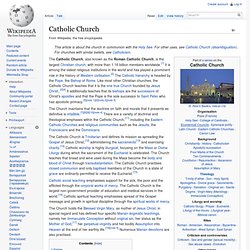
The Catholic Church is the largest non-government provider of education and medical services in the world.[16] Catholic spiritual teaching emphasises spread of the Gospel message and growth in spiritual discipline through the spiritual works of mercy. The Church holds the Blessed Virgin Mary, as mother of Jesus Christ, in special regard and has defined four specific Marian dogmatic teachings, namely her Immaculate Conception without original sin, her status as the Mother of God,[17] her perpetual virginity and her bodily Assumption into Heaven at the end of her earthly life.[18][note 5] Numerous Marian devotions are also practised.